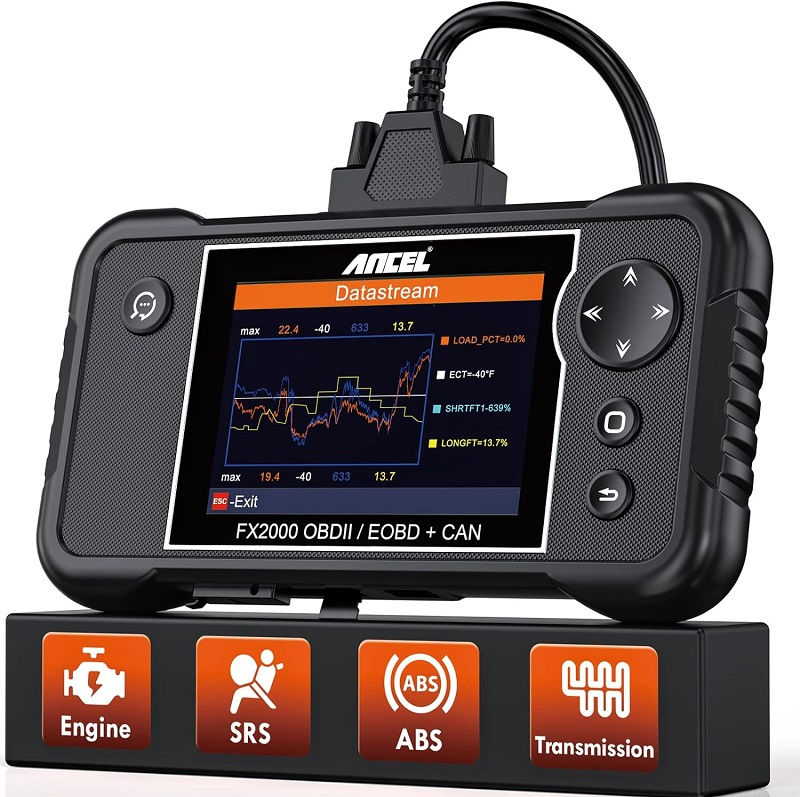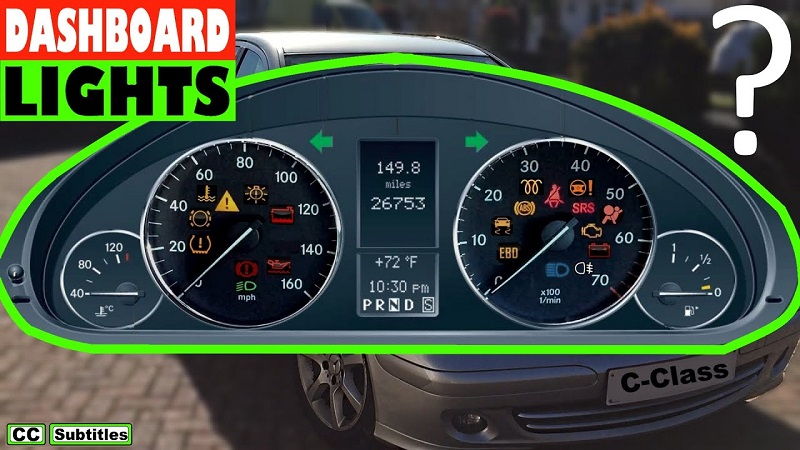This post contains affiliate links. This means I will make a commission at no extra cost to you should you click through and make a purchase [ “As an Amazon Associate, I earn from qualifying purchases.” ]. Read the full disclosure here.
Mercedes Dashboard Warning Lights Explained GuideMechanic.Com As a Mercedes owner, understanding the meaning behind the dashboard warning lights is crucial for maintaining the health of your vehicle.
These warning lights serve as a built-in diagnostic system, providing important information about potential issues that require attention.
In this comprehensive guide, we will delve into the various warning lights that you may encounter on your Mercedes dashboard, decipher their meanings, and provide you with the necessary knowledge to take appropriate action.
The Importance of Dashboard Warning Lights

When you start your Mercedes, the dashboard warning lights illuminate momentarily as a part of the system check. These warning lights are more than just colorful symbols; they are your vehicle’s early warning system, alerting you to potential problems that may arise.
Ignoring these warning lights can lead to further damage and costly repairs, so it is crucial to understand their meanings and take appropriate action.
Dashboard warning lights can indicate a range of issues, from simple maintenance reminders to more serious problems with your vehicle’s systems.
By paying attention to these warning lights, you can address potential issues before they escalate, saving you both time and money in the long run.
It is important to note that these lights should not be ignored, even if your vehicle seems to be functioning normally. They act as an early detection system, and ignoring them could result in severe consequences.
Recognizing the Warning Light Symbols
Before diving into the specific warning lights, it is essential to familiarize yourself with the symbols that Mercedes uses to represent them. Each warning light has its unique symbol, color, and corresponding action you should take.
These symbols are usually located on the dashboard near the speedometer and tachometer, making them easily visible to the driver. By understanding the symbols, you can quickly identify the issue and take appropriate action.
Understanding the Colors of Warning Lights
Mercedes warning lights come in different colors, each representing a specific level of urgency. Red warning lights indicate more severe issues that require immediate attention, while yellow lights signify less critical problems.
Green or blue lights, on the other hand, are generally informational rather than indicating a problem. Understanding the colors will help you gauge the level of urgency and take appropriate action accordingly.
Common Warning Lights and Their Meanings

The Mercedes dashboard is equipped with various warning lights, each indicating a specific problem or system malfunction.
Understanding the meaning behind these warning lights is crucial for prompt diagnosis and resolution. Let’s explore some of the most commonly encountered warning lights in Mercedes vehicles and their respective meanings:
Engine Warning Light
The engine warning light, often depicted as a symbol resembling an engine block, indicates a problem with your vehicle’s engine or associated components.
It could be triggered by issues such as a malfunctioning sensor, a misfire, or a problem with the emissions control system. When this light illuminates, it is advisable to have your vehicle inspected by a qualified mechanic to diagnose and resolve the underlying issue.
Brake System Warning Light
The brake system warning light, typically represented by an exclamation mark inside a circle or the word “BRAKE,” indicates a problem with your vehicle’s braking system. This could be due to low brake fluid, worn brake pads, or a malfunctioning brake system component.
It is crucial not to ignore this warning light, as it directly affects your vehicle’s safety. Have your brakes inspected and serviced immediately to ensure optimal braking performance.
ABS Warning Light
The ABS (Anti-lock Braking System) warning light, often depicted as the letters “ABS” inside a circle, indicates a malfunction in the ABS system.
The ABS helps prevent the wheels from locking up during sudden braking or when driving on slippery surfaces. When this warning light illuminates, it suggests that the ABS system may not be functioning correctly. It is advisable to have your vehicle inspected by a qualified technician to diagnose and repair the issue.
Airbag Warning Light
The airbag warning light, usually depicted as an icon of a person with an inflated airbag in front, indicates a problem with your vehicle’s airbag system.
This warning light should not be taken lightly, as it signifies a potential issue that could compromise the effectiveness of your airbags in the event of an accident. Have your vehicle inspected by a professional to diagnose and rectify the problem promptly.
Tire Pressure Monitoring System Warning Light
The tire pressure monitoring system (TPMS) warning light, often depicted as an exclamation mark inside a horseshoe shape or the letters “TPMS,” indicates a problem with your vehicle’s tire pressure.
This warning light illuminates when one or more of your tires have low air pressure. It is important to address this issue promptly, as incorrect tire pressure can lead to compromised handling, reduced fuel efficiency, and increased tire wear.
Oil Pressure Warning Light
The oil pressure warning light, typically represented by an oil can symbol, indicates a problem with your vehicle’s oil pressure. Low oil pressure can lead to engine damage, so it is essential to address this issue immediately.
Check your oil level and ensure it is at the recommended level. If the light continues to illuminate, have your vehicle inspected by a qualified mechanic to diagnose and resolve the issue.
Battery Charge Warning Light
The battery charge warning light, often depicted as a battery symbol, indicates a problem with your vehicle’s charging system.
This warning light illuminates when the battery is not receiving sufficient charge or when there is a problem with the alternator.
Driving with a faulty charging system can lead to a drained battery and eventual engine failure. Have your vehicle inspected by a professional to determine the cause of the issue and rectify it promptly.
Check Engine Light
The check engine light, often represented by the words “CHECK ENGINE” or an engine symbol, indicates a potential issue with your vehicle’s engine or emissions system.
It could be triggered by various factors, such as a faulty sensor, a loose gas cap, or an issue with the catalytic converter. When this light illuminates, it is recommended to have your vehicle’s onboard diagnostics system scanned to identify the specific problem and take appropriate action.
Transmission Warning Light
The transmission warning light, often depicted as a gear symbol or the words “TRANS” or “GEAR,” indicates a problem with your vehicle’s transmission system.
This warning light could be triggered by issues such as low transmission fluid, a faulty sensor, or a more significant transmission problem.
It is crucial to address this issue promptly, as driving with a malfunctioning transmission can lead to costly repairs. Have your vehicle inspected by a qualified technician to diagnose and resolve the underlying problem.
Coolant Temperature Warning Light
The coolant temperature warning light, usually depicted as a thermometer symbol or the word “TEMP,” indicates that your vehicle’s engine is overheating. This warning light should not be ignored, as driving with an overheated engine can cause severe damage.
Pull over to a safe location, let the engine cool down, and check the coolant level. If the light continues to illuminate, have your vehicle inspected by a professional to diagnose and repair the cooling system.
ESP/BAS Warning Light
The ESP (Electronic Stability Program)/BAS (Brake Assist System) warning light, often depicted as a car skidding or the words “ESP” or “BAS,” indicates a problem with your vehicle’s stability control or brake assist system.
These systems help maintain vehicle stability and enhance braking performance. When this warning light illuminates, it suggests that one or both of these systems may not be functioning correctly. Have your vehicle inspected by a qualified technician to diagnose and repair the issue.
Red Warning Lights

Red warning lights on your Mercedes dashboard indicate more severe issues that require immediate attention. Ignoring these warning lights can lead to further damage and compromise the safety and performance of your vehicle. Let’s explore some of the commonly encountered red warning lights and their potential meanings:
Engine Temperature Warning Light
The engine temperature warning light, often depicted as a thermometer inside a triangle or the word “TEMP,” illuminates when your vehicle’s engine is overheating.
This warning light should never be ignored, as driving with an overheated engine can cause severe damage. Pull over to a safe location, turn off the engine, and wait for it to cool down.
Check the coolant level and radiator for any leaks. If the problem persists, have your vehicle inspected by a professional to diagnose and repair the cooling system.
Oil Pressure Warning Light
The oil pressure warning light, typically represented by an oil can symbol, illuminates when your vehicle’s oil pressure drops below the recommended level. Low oil pressure can lead to engine damage, so it is essential to address this issue immediately.
Check your oil level and ensure it is at the recommended level. If the light continues to illuminate, have your vehicle inspected by a qualified mechanic to diagnose and resolve the issue.
Battery Charge Warning Light
The battery charge warning light, often depicted as a battery symbol, illuminates when your vehicle’s battery is notreceiving sufficient charge or when there is a problem with the alternator.
Driving with a faulty charging system can lead to a drained battery and eventual engine failure. Check the battery connections and ensure they are secure.
If the light continues to illuminate, have your vehicle inspected by a professional to determine the cause of the issue and rectify it promptly.
Brake System Warning Light
The brake system warning light, usually represented by an exclamation mark inside a circle or the word “BRAKE,” illuminates when there is a problem with your vehicle’s braking system.
This could be due to low brake fluid, worn brake pads, or a malfunctioning brake system component. It is crucial not to ignore this warning light, as it directly affects your vehicle’s safety.
Check the brake fluid level and top it up if necessary. If the light persists, have your brakes inspected and serviced immediately to ensure optimal braking performance.
Transmission Warning Light
The transmission warning light, often depicted as a gear symbol or the words “TRANS” or “GEAR,” illuminates when there is a problem with your vehicle’s transmission system.
This warning light could be triggered by issues such as low transmission fluid, a faulty sensor, or a more significant transmission problem.
It is crucial to address this issue promptly, as driving with a malfunctioning transmission can lead to costly repairs. Check the transmission fluid level and ensure it is at the recommended level.
If the light continues to illuminate, have your vehicle inspected by a qualified technician to diagnose and resolve the underlying problem.
Steering System Warning Light
The steering system warning light, usually depicted as a steering wheel or the words “STEERING,” illuminates when there is a problem with your vehicle’s power steering system.
This warning light could indicate a low power steering fluid level or a malfunctioning power steering component. It is important not to ignore this warning light, as it can affect your ability to steer the vehicle safely.
Check the power steering fluid level and top it up if necessary. If the light persists, have your vehicle inspected by a professional to diagnose and repair the power steering system.
Airbag Warning Light
The airbag warning light, often depicted as an icon of a person with an inflated airbag in front, illuminates when there is a problem with your vehicle’s airbag system.
This warning light should not be taken lightly, as it signifies a potential issue that could compromise the effectiveness of your airbags in the event of an accident. Have your vehicle inspected by a professional to diagnose and rectify the problem promptly.
ESP/BAS Warning Light
The ESP (Electronic Stability Program)/BAS (Brake Assist System) warning light, often depicted as a car skidding or the words “ESP” or “BAS,” illuminates when there is a problem with your vehicle’s stability control or brake assist system.
These systems help maintain vehicle stability and enhance braking performance. When this warning light illuminates, it suggests that one or both of these systems may not be functioning correctly.
Check the brake fluid level and top it up if necessary. If the light persists, have your vehicle inspected by a qualified technician to diagnose and repair the issue.
Red Warning Lights Summary
Red warning lights on your Mercedes dashboard indicate more severe issues that require immediate attention. It is crucial not to ignore these warning lights, as doing so can lead to further damage and compromise the safety and performance of your vehicle. If any of these red warning lights illuminate, it is advisable to take the following steps:
1. Safely pull over to the side of the road and turn off the engine.
2. Consult your vehicle’s owner’s manual to understand the specific meaning of the warning light.
3. If possible, check the fluid levels and top them up if necessary.
4. If the problem persists or you are unsure of the underlying issue, contact a qualified mechanic or your Mercedes dealership for assistance.
Yellow Warning Lights
See Also: Mercedes Dashboard Symbols and Meanings
Yellow warning lights on your Mercedes dashboard indicate less critical problems compared to red lights. While they may not require immediate attention, it is still essential to address these issues to maintain the optimal performance of your vehicle. Let’s explore some of the commonly encountered yellow warning lights and their potential meanings:
Tire Pressure Monitoring System Warning Light
The tire pressure monitoring system (TPMS) warning light, often depicted as an exclamation mark inside a horseshoe shape or the letters “TPMS,” illuminates when one or more of your tires have low air pressure.
This warning light serves as a reminder to check your tire pressure and ensure it is at the recommended level. Incorrect tire pressure can lead to compromised handling, reduced fuel efficiency, and increased tire wear. Use a tire pressure gauge to check the pressure in all four tires and inflate or deflate them as needed to match the recommended levels.
Service Reminder Light
The service reminder light, often depicted as a wrench symbol, illuminates to remind you that your vehicle is due for routine maintenance or a specific service.
It could indicate that an oil change, filter replacement, or other scheduled maintenance is required. Refer to your vehicle’s owner’s manual or service schedule to determine the specific maintenance task that needs to be performed. Once the necessary maintenance is completed, you can reset the service reminder light to ensure accurate future reminders.
ESP/BAS Warning Light
The ESP (Electronic Stability Program)/BAS (Brake Assist System) warning light, often depicted as a car skidding or the words “ESP” or “BAS,” illuminates when there is a problem with your vehicle’s stability control or brake assist system. While this warning light is yellow, indicating a less critical issue, it is still important to have it addressed.
The systems associated with this warning light help maintain vehicle stability and enhance braking performance. Have your vehicle inspected by a qualified technician to diagnose and repair the issue.
Check Engine Light
The check engine light, often represented by the words “CHECK ENGINE” or an engine symbol, illuminates when there is a potential issue with your vehicle’s engine or emissions system.
It could be triggered by various factors, such as a faulty sensor, a loose gas cap, or an issue with the catalytic converter. While a yellow check engine light may not indicate an immediate problem, it is still essential to have your vehicle’s onboard diagnostics system scanned to identify the specific issue.
Ignoring the check engine light can lead to more severe problems and may affect your vehicle’s fuel efficiency and emissions performance.
Yellow Warning Lights Summary
Yellow warning lights on your Mercedes dashboard indicate less critical issues that still require attention. Although they may not require immediate action, it is advisable to address these issues promptly to prevent further complications. If any of these yellow warning lights illuminate, consider taking the following steps:
1. Consult your vehicle’s owner’s manual to understand the specific meaning of the warning light.
2. Check for any obvious signs of the issue, such as low tire pressure or a loose gas cap.
3. If the issue is within your capabilities, take appropriate action, such as inflating the tires to the recommended pressure or tightening the gas cap.
4. If you are unsure of the underlying issue or unable to resolve it yourself, contact a qualified mechanic or your Mercedes dealership for assistance.
Green and Blue Warning Lights
Green and blue warning lights on your Mercedes dashboard are generally informational rather than indicating a problem. These lights provide you with important information about specific vehicle functions or features. Let’s explore some of the commonly encountered green and blue warning lights and their purposes:
Turn Signal Indicator
The turn signal indicator, often depicted as a green arrow pointing left or right, illuminates when you activate the turn signal to indicate your intention to change lanes or make a turn.
This light serves as a reminder to cancel the turn signal once you have completed the maneuver. It is important to use your turn signals properly to communicate your intentions to other drivers on the road and ensure safe driving practices.
High Beam Indicator
The high beam indicator, usually depicted as a blue icon representing a headlight beam, illuminates when you activate the high beam headlights.
This light serves as a reminder to turn off the high beams when approaching other vehicles or driving in well-lit areas. Proper use of high beam headlights ensures optimal visibility while minimizing glare for other drivers on the road.
Information Display Indicators
Your Mercedes may have various green or blue indicators on the information display screen, providing you with important information about your vehicle’s status or features.
These indicators could include information about the exterior temperature, cruise control activation, lane-keeping assist, or other vehicle functions.
Familiarize yourself with the meanings of these indicators through your vehicle’s owner’s manual to fully utilize the features and functions of your Mercedes.
Green and Blue Warning Lights Summary
Green and blue warning lights on your Mercedes dashboard provide you with important information about specific vehicle functions or features.
While they do not indicate a problem, it is still essential to understand their meanings to utilize your vehicle’s features effectively.
Familiarize yourselfwith the meanings of these green and blue warning lights through your vehicle’s owner’s manual to ensure you fully understand and utilize the features and functions of your Mercedes.
Flashing Warning Lights
Flashing warning lights on your Mercedes dashboard typically indicate more severe issues that require immediate attention.
When these lights start flashing, it is crucial not to ignore them, as they often suggest a significant problem that needs urgent resolution. Let’s explore some of the commonly encountered flashing warning lights and their potential meanings:
Flashing Engine Warning Light
The flashing engine warning light, often depicted as a symbol resembling an engine block, indicates a severe problem with your vehicle’s engine that requires immediate attention. This could be due to a misfire, a significant sensor malfunction, or a critical issue with the emissions control system.
When this light starts flashing, it is crucial to pull over to a safe location, turn off the engine, and have your vehicle inspected by a qualified mechanic. Ignoring a flashing engine warning light can lead to severe engine damage and may leave you stranded on the road.
Flashing Battery Charge Warning Light
The flashing battery charge warning light, often depicted as a battery symbol, indicates a critical problem with your vehicle’s charging system.
This could be due to a faulty alternator or a complete loss of battery charge. When this light starts flashing, it suggests that your vehicle’s electrical system is not functioning correctly and may result in a drained battery and engine failure.
It is crucial to address this issue immediately by contacting a qualified mechanic or your Mercedes dealership for assistance.
Flashing ABS Warning Light
The flashing ABS (Anti-lock Braking System) warning light, often depicted as the letters “ABS” inside a circle, indicates a severe malfunction in the ABS system. The ABS helps prevent the wheels from locking up during sudden braking or when driving on slippery surfaces.
When this warning light starts flashing, it suggests that the ABS system is not functioning correctly, compromising your vehicle’s braking performance. It is crucial to have your vehicle inspected by a qualified technician as soon as possible to diagnose and repair the ABS system.
Flashing Airbag Warning Light
The flashing airbag warning light, usually depicted as an icon of a person with an inflated airbag in front, indicates a significant problem with your vehicle’s airbag system.
This warning light should never be ignored, as it signifies a potential issue that could compromise the effectiveness of your airbags in the event of an accident.
When this light starts flashing, it is crucial to have your vehicle inspected by a professional to diagnose and rectify the problem promptly.
Flashing Yellow Warning Lights Summary
Flashing warning lights on your Mercedes dashboard indicate severe issues that require immediate attention. When these lights start flashing, it is essential to take immediate action to prevent further damage and ensure your safety on the road. If any of these flashing warning lights illuminate, consider taking the following steps:
1. Safely pull over to the side of the road and turn off the engine.
2. Contact a qualified mechanic or your Mercedes dealership for assistance.
3. Avoid driving the vehicle until the underlying issue is diagnosed and resolved.
Resetting Dashboard Warning Lights
After you have resolved the underlying problem indicated by the warning lights on your Mercedes dashboard, it is important to reset the warning lights to accurately reflect the current state of your vehicle. Here’s how you can reset the warning lights:
Consult the Owner’s Manual
Refer to your vehicle’s owner’s manual for specific instructions on how to reset the warning lights. Mercedes models may have different procedures for resetting the lights, so it is essential to follow the manufacturer’s guidelines.
Disconnect the Battery
In some cases, disconnecting the vehicle’s battery for a few minutes can reset the warning lights. However, this method should be used with caution, as disconnecting the battery can also reset other settings and systems in your vehicle. Consult your owner’s manual or seek professional assistance if you are unsure.
Use a Diagnostic Tool
If you have access to a diagnostic tool, you can use it to reset the warning lights on your Mercedes. These tools can communicate with your vehicle’s onboard diagnostics system and provide options to reset the lights. Follow the instructions provided by the diagnostic tool manufacturer.
Conclusion
In conclusion, understanding the meaning behind the warning lights on your Mercedes dashboard is crucial for maintaining the performance and longevity of your vehicle.
By familiarizing yourself with the symbols, colors, and meanings of these lights, you can quickly identify potential issues and take appropriate action.
Whether it’s a red warning light that requires immediate attention or a yellow light that indicates less critical problems, addressing these issues promptly will ensure a smooth and safe driving experience with your Mercedes.
Remember, regular maintenance, prompt action, and seeking professional assistance when needed are key to keeping your Mercedes in optimal condition.
Related video of Mercedes Dashboard Warning Lights Explained: A Comprehensive Guide
- BMW Catalytic Converter Price: What You Need to Know - April 24, 2025
- Scrap Catalytic Converter Price - April 24, 2025
- Honda CR-V Catalytic Converter Price - April 24, 2025

